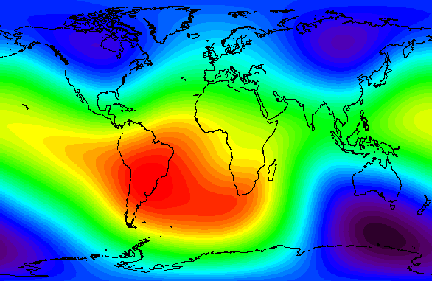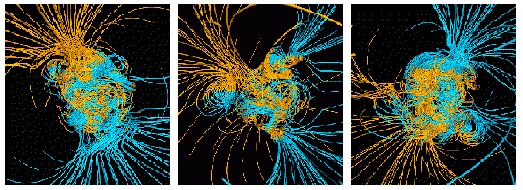“A reversal could knock out power grids, hurt astronauts and satellites, widen atmospheric ozone holes, send polar auroras flashing to the equator and confuse birds, fish and migratory animals that rely on the steadiness of the magnetic field as a navigation aid.”
– The New York Times, July 13, 2004


July 23, 2004 Santa Cruz, California – Magnetic field lines have been coming out of the south pole and entering the north pole of the earth for the past 780,000 years. That is called the magnetic dipole. But now scientists have been monitoring the strongest change humans have ever recorded in the magnetic field at the surface of the earth’s internal iron core four thousand miles down. The result, according to French geophysicist Gauthier Hulot, is that the South Atlantic below Africa and South America now have a magnetic field that is 30% weaker than the rest of the planet. Already some satellites passing over that weak magnetic field have suffered electronic failures because charged particles from the sun can penetrate more easily in a weak magnetic field. And over the past century, the global magnetic field has weakened about 10 to 15 percent. Recently, that magnetic field deterioration has accelerated, provoking scientists to wonder if it will build up to a pole reversal in which compasses will point to the south instead of the north.
One scientist began building computer simulations of the earth’s magnetic field while he worked at Los Alamo National Laboratory for sixteen years. He is Gary Glatzmaier, Ph.D. in physics. Now Dr. Glatzmaier is Professor of Earth Sciences at the University of California – Santa Cruz, where he has continued to build computer models of the earth’s fluid iron core and resulting magnetic poles. Dr. Glatzmaier says his simulations show that the earth’s liquid iron core is always moving, trying to get rid of heat. As that liquid iron metal moves up and down, it generates large electric currents and then magnetic fields. Sometimes the liquid iron movement can generate magnetic fields in opposite direction of the earth’s dipole. In his computer modeling, such reverse core patches continue to grow and overwhelm the original polarity. That’s when there is a reversal of the poles, often preceded by a weakening of the earth’s magnetic field. According to analysis of some earth geology, pole reversals have happened on average about three times every million years. The last one was 780,000 years ago, so maybe our planet is overdue for a change.
Interview:
Gary A. Glatzmaier, Ph.D., Prof. of Earth Sciences, University of California – Santa Cruz, Earth Sciences Department, Santa Cruz, California: “Its intensity appears to be decreasing and fairly rapidly but a lot of people suggest that this indicates the magnetic field is about to reverse. However and people know this in the geomagnetic and paleomagnetic community if you look in the records of magnetic remnants.
LIKE VOLCANOES.
Like volcanoes or ocean bottom where material cooled and when it cools below a certain temperature, it captures the direction and intensity of the magnetic field location at that time. If you look at that record, you see that the field has been either increasing or decreasing all the time. It is never constant. And it tends to go for several thousands of years, maybe even tens of thousands of years, in one direction for example, keep increasing slowly. Then, it will start to decrease for say ten thousand years or more. Then, it will start increasing again. This keeps going all the time.
It’s true that when a reversal has occurred, it is accompanied by a very weak magnetic field. In other words, the field just keeps decreasing and decreasing, and eventually it does not go to zero but gets very weak and the major part of it, the dipole part of it, actually collapses and gets re-established in the opposite polarity.
Just because it is decreasing now, doesn’t mean it’s going to reverse. It could, and we haven’t had a reversal for a long time actually a longer time than the average time between reversals. The last time was 780,000 years ago.
Average Earth Time Between Magnetic Pole Reversals
The average time between reversals is more like 200,000 years. But it’s not every 200,000 years. It can be much shorter than that or much longer than that. So just because it is reversing now doesn’t mean it WILL reverse and if it does reverse, the soonest it will reverse will probably be 1,000 to 2,000 years from now.
780,000 YEARS AGO, THE LAST TIME THAT THE NORTH AND SOUTH POLES CHANGED PLACE IS THERE ANYTHING IN VOLCANIC SEDIMENTS OR OTHER ROCK SEDIMENTS THAT INDICATE WHETHER THERE WAS IMPACT ON EARTH LIFE AT THAT TIME?
A correlation between species generation and extinction with magnetic field reversals has not been established, as far as I can tell. What happens is the field becomes small and very weak during a reversal and it just allows more cosmic radiation to come in from the sun and from other stars, mainly from the sun. And cosmic radiation are particles like protons and electrons.
Impact of Weak Magnetic Field On Earth Life and Technologies
THAT CAN HURT EARTH’S LIFE, ALL OF US?
Yes, it can. If these particles actually make it through the atmosphere and they pass through us or through some creature or plant life, because they are charged they can change molecular structure as they pass through. They can disturb the molecular structure and the DNA structure. So, possibly cause mutations.
AND MORE SKIN CANCER.
Oh, probably, yeah just because you are having basic molecular and cell structure being damaged by these particles that come through.
ALSO SATELLITES AND GPS SYSTEMS WE’VE GOT THE PROBLEM THAT A WEAKENING MAGNETIC FIELD THAT ALLOWS IN MORE SOLAR RADIATION IS GOING TO HURT THEM AS WELL.
That’s right. Another thing I should mention is although the last full reversal was 780,000 years ago, there is some evidence that there have been attempted reversals in other words, the field has attempted to reverse several times since then. The latest has been something like 35,000 years ago where certain places on the earth it looks like the field did reverse and then within 10,000 years or so, it reversed back again.
So, and this occurs in my computer simulations quite often. The field attempts to reverse and it looks like it’s reversing or it actually does reverse in certain areas but then it doesn’t last. The original polarity is able to recover and eventually you get the same polarity back again.
But you have these attempted reversals and during those attempts, the field can become weak. You still have the increasing solar and cosmic radiation on the earth. So, it probably does happen more frequently. And maybe this current anomaly in the South Atlantic, that may end up being an attempted reversal. But, if it keeps getting if the anomaly keeps getting stronger and the field gets weaker in this area, that can also cause problems, even if there is no reversal.
SATELLITES MOVING OVER THE SOUTHERN ATLANTIC HAVE ALREADY HAD PROBLEMS.
That’s right. For satellites above the atmosphere, the magnetic field is the only shield. So when the field is weakening, the satellites’ electronics and instruments are going to be susceptible to damage.
Ozone Deterioration in a Weak Magnetic Field Means
Increased Ultraviolet Radiation and Damage to Earth Life
When the earth’s magnetic field is weak, more solar radiation from the sun can reach the atmosphere. That means that solar storms that release energetic particles toward earth could damage the ozone layer even more than it thinned now by industrial pollution. The more the ozone layer deteriorates, the more harmful ultraviolet radiation reaches the earth’s surface where it can damage life.
Could Poles Reverse in the Next Century?
WHAT’S THE POSSIBILITY THAT THE POLES COULD REVERSE IN JUST THE NEXT 100 OR 200 YEARS?
What’s the possibility? Well, I hate to say anything is impossible, but there’s really no evidence that it could happen that quickly. Certainly, it doesn’t happen that quickly in the computer simulation. But the computer simulations are very crude, so they certainly don’t capture all the physics.
I’d say, based on all our studies and computer simulations and observations in paleomagnetic measurements, it’s highly unlikely. Let’s put it that way.
IN THE 160 MILLION YEARS OF HISTORY THAT YOU’VE GOT ON THE BOTTOM OF THE OCEAN, HOW MANY POLE REVERSALS HAVE YOU BEEN ABLE TO DOCUMENT?
Probably on the order of maybe 300 or so. I don’t know the exact number. But on average, it’s two or three per million years. Something like that.
THE LAST WAS 780,000 YEARS AGO, SO IF IT AVERAGED THREE TIMES EVERY MILLION YEARS, WE REALLY ARE SORT OF OVERDUE FOR A MAGNETIC POLE CHANGE.
Yeah, overdue in the sense that it’s been longer than the average, but like I said, there have been times when it’s been much longer than that. You shouldn’t expect the time between reversals to be the average all the time because it varies so much. But you are right, it could very likely happen. It could be happening now. Or maybe not. It’s probably a 50/50 chance.”

In June, the European Space Agency (ESA) confirmed funding for three satellites referred to as “Swarm” to be launched in 2009 to monitor the dynamics of the Earth’s magnetic field more accurately than ever before.
More Information:
Known History of Earth’s Magnetic Reversals
Dr. Glatzmaier: “There is a record that goes back roughly 160 million years. Now that’s not a large portion the earth is about 4.5 billion years old. The record that comes from the ocean floor is only about 160 million years old. The reason is that it goes back to when the North American and European continents were altogether (Gonwanaland). It’s been almost 200 million years since they began separating. They are still separating out slowly. But as they separate, the middle of the Atlantic keeps uprising basically and producing more ocean floor as the two continents separate. The ocean floor gets created by melted material from below which rises and spreads apart. As it comes to the surface at the bottom of the ocean, it cools. And as it cools below what is called the ‘Curie temperature,’ then it can support permanent magnetism. Then it will capture a magnetic field and have a permanent magnet and the field will be in the direction of the earth’s magnetic field at that time.
So, that’s how they discovered on the ocean floor as you move away from the ridge of this mid-ocean ridge, you see the magnetic field that is captured in the floor to change direction as you move away from that ridge. The further you are from the ridge, the further back in time you are. So, that’s how they get a record. They estimate how old or fast the floor has been spreading apart and they can then estimate the time between the magnetic reversals.
There are also remnants in lake and ocean bottoms, based on sediments. they can estimate how much sediment you get per year and measure the magnetic remnant on the lake bottom. Or also in lava flows. As lava flows out of volcanoes, as it cools it will capture the magnetic field. The only problem there is that it doesn’t flow for very long.”
Websites:
http://www.es.ucsc.edu/~glatz/geodynamo.html
http://denali.gsfc.nasa.gov/research/mag_field/purucker/mag_missions.html
© 1998 - 2025 by Linda Moulton Howe.
All Rights Reserved.

